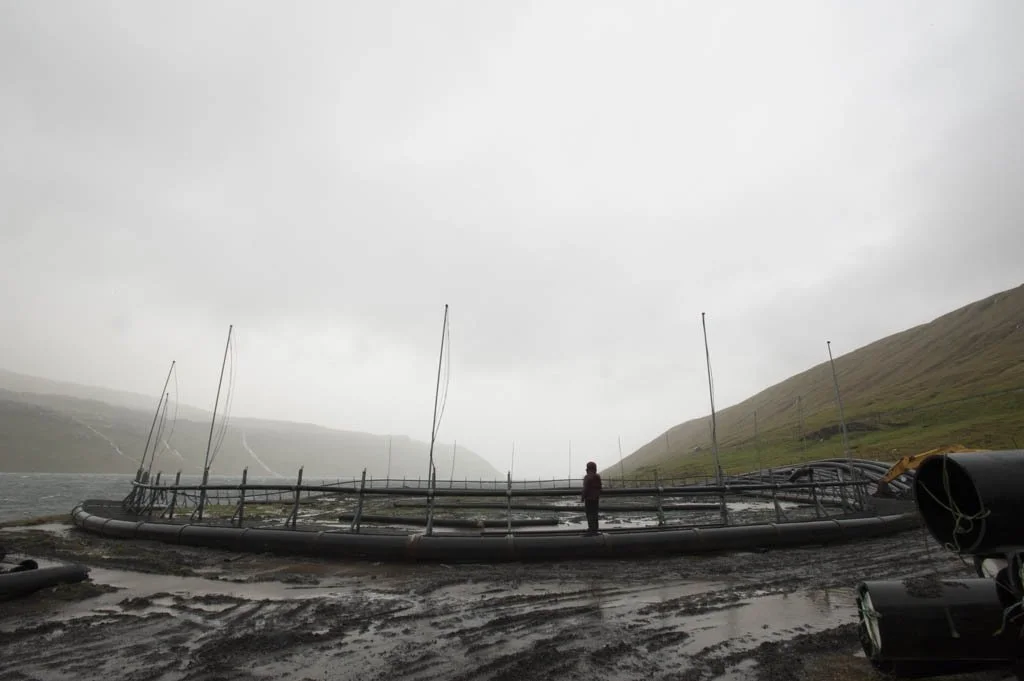
Salmon Free Falklands fact-finding visit to the Faroe Islands
Photo shows Kaldbakfjord where salmon farming is no longer possible due to over-nutrification
Members of Salmon Free Falklands spent a week in the Faroe Islands in October 2025. They met with a wide range of people, from government officers and the non-governmental environmental organisation (FNU), to individuals and professionals from the local community who had concerns about the impact that salmon farming is having on their islands.
The main finding, reiterated by all quarters, was that several fjords where salmon had previously been farmed, have now been deemed too polluted by over-nutrification to sustain the industry there. This is forcing companies to seek new sites that are ever farther out at sea, where the ocean currents are stronger.
The visit was entirely funded by local members of Salmon Free Falklands.
Open-pen salmon farming in the Faroes is often held up as having the highest standards of regulation and environmental protection. Indeed, FIG officers visited the Faroes in May 2025, believing the Islands to be a 'good comparator for the Falklands'. The SFF visit revealed a different story.
● The inshore water around the Faroes is much deeper than in the Falklands.
● The near-shore currents around the Faroes are typically 2-3 times stronger than in Falklands waters.
● The islands of the Faroes form multiple straits, allowing the ocean to flush through between them.
● The Faroes receive more than twice as much precipitation as the Falklands. This boosts their ability to run smolt facilities and do freshwater de-licing.
● Salmon production in the Faroes peaked at around 90,000 tonnes per annum in 2021, while Unity Marine Ltd see the potential to produce 200,000 tonnes p.a. in Falklands waters. This would generate more than twice as much effluent as in the Faroes.
● In the Faroes, about 55,000 people live on 1,400 sq km; in the Falklands, about 3,500 people live on 8.6 times the landmass (12,000 sq km). This impacts the Falklands’ capacity to monitor and regulate an industry that takes place in remote bays.
The Faroes differ from the Falklands in many significant ways:
“The contribution of the Faroese salmon farming industry to the Faroes’ GDP is minimal. Because the majority of the companies are foreign-owned, the profits go mostly overseas.
”The Faroes are ideal for growing Atlantic salmon, these waters are where wild adult Atlantic salmon have always thrived. It’s not reasonable to assume that the Falklands can provide similarly high yields. Bakkafrost, for example, have found this in Scotland, where they cannot produce the same good results as in the Faroes.”
People in the Faroes expressed serious concerns about the negative impacts of open-pen salmon farming:
“The capacity of the regulators is inadequate; it does not match the capacity and power of the companies.”
“The Faroe Islands cannot be used as a good example of environmentally responsible salmon farming. There is a lack of regulations, monitoring and baseline studies, and in some fjords the seabed is completely dead. There is also a high risk of lice and parasites that can endanger endemic species.”
“Seals definitely find ways to break into the salmon pens. Shooting seals was legal until 2020, but then the USA stopped importing salmon from where seals were allowed to be killed. Nonetheless, from time to time I can hear rifle shots, indicating the seals still do get killed near salmon pens. And seals sometimes wash ashore dead with gunshot wounds, but mostly such carcasses would just drift straight out into the nearby open ocean.”
“The Faroese Environment Agency realises that we are not able to answer questions about how historic anthropogenic activity has impacted the fjords. There is no baseline data from before salmon farming started.”
Image of the anoxic ‘dead’ seabed under Faroese salmon pens, as seen in the Faroese documentary Undir laksin (Under the Salmon). Image credit KVF, the Faroes’ leading broadcasting service
-
The official blurb for the one-hour documentary Undir laksin (Under the Salmon):
“The salmon farming industry exports billions every year, but the industry has many environmental drawbacks. While the industry has grown to huge proportions, no one has investigated the long-term consequences of salmon farming activities on the Faroese nature.
“This is the story of what happens beneath the water surface – about the downsides of a booming salmon farming industry, a sluggish political system, a hardened investment culture, and a silent – and somewhat forgotten – Faroese Nature.”
The documentary highlights major forms of pollution caused by open-pen salmon farming in the Faroe Islands:
sea lice proliferation
chemical use
escape of farmed salmon
effluent output
While the documentary is in Faroese, the footage of dead zones under Faroese salmon farms speaks for itself. This can be seen at minutes 2:45, 6:02, 6:41 and 53:28.
You can watch the documentary here.
-
The FNU website calls attention to the serious environmental and health issues caused by the ever-growing plastic pollution (both macro and micro) generated by salmon farming in the Faroe Islands.
Citizens have since 2019 tried to get the authorities to do something about the problem. The municipality has received a warning from the Environmental Agency, and the matter has also been addressed by the Parliamentary Ombudsman, who supported the citizens.
Nevertheless, the plastic pollution continues due to regulatory loopholes and oversights. -
In 2018, residents of Oyndarfjord successfully campaigned to halt the expansion of open-pen salmon farming in their fjord.
The community had already witnessed the degradation of their traditional inshore fishing grounds and they didn’t want their recreational activities further impinged on by industrial salmon farming.
-
In 2018, 200 people participated in a two hour hike to Virkum to express their opposition to a proposed new salmon farm near this pristine coastline.
They were not successful.
Images from the fact-finding trip to the Faroe Islands
Floatation pipes used at salmon production pens
Discarded salmon pen
Polystyrene inside floatation pipes
Wear and tear in evidence; the shredded plastics surely lost into the sea








